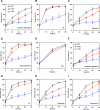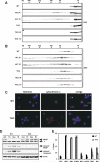BID, BIM, and PUMA are essential for activation of the BAX- and BAK-dependent cell death program
- PMID: 21127253
- PMCID: PMC3163443
- DOI: 10.1126/science.1190217
BID, BIM, and PUMA are essential for activation of the BAX- and BAK-dependent cell death program
Abstract
Although the proteins BAX and BAK are required for initiation of apoptosis at the mitochondria, how BAX and BAK are activated remains unsettled. We provide in vivo evidence demonstrating an essential role of the proteins BID, BIM, and PUMA in activating BAX and BAK. Bid, Bim, and Puma triple-knockout mice showed the same developmental defects that are associated with deficiency of Bax and Bak, including persistent interdigital webs and imperforate vaginas. Genetic deletion of Bid, Bim, and Puma prevented the homo-oligomerization of BAX and BAK, and thereby cytochrome c-mediated activation of caspases in response to diverse death signals in neurons and T lymphocytes, despite the presence of other BH3-only molecules. Thus, many forms of apoptosis require direct activation of BAX and BAK at the mitochondria by a member of the BID, BIM, or PUMA family of proteins.
Figures




Comment in
-
Cell biology. Opening the cellular poison cabinet.Science. 2010 Dec 3;330(6009):1330-1. doi: 10.1126/science.1199461. Science. 2010. PMID: 21127237 No abstract available.
-
Can the analysis of BH3-only protein knockout mice clarify the issue of 'direct versus indirect' activation of Bax and Bak?Cell Death Differ. 2011 Oct;18(10):1545-6. doi: 10.1038/cdd.2011.100. Cell Death Differ. 2011. PMID: 21909118 Free PMC article. No abstract available.
References
-
- Gross A, McDonnell JM, Korsmeyer SJ. Genes Dev. 1999;13:1899. - PubMed
-
- Wang X. Genes Dev. 2001;15:2922. - PubMed
-
- Newmeyer DD, Ferguson-Miller S. Cell. 2003 Feb 21;112:481. - PubMed
-
- Reed JC. Cell Death Differ. 2006 Aug;13:1378. - PubMed
-
- Youle RJ, Strasser A. Nat Rev Mol Cell Biol. 2008 Jan;9:47. - PubMed
Publication types
MeSH terms
Substances
Grants and funding
LinkOut - more resources
Full Text Sources
Other Literature Sources
Molecular Biology Databases
Research Materials

